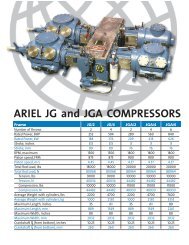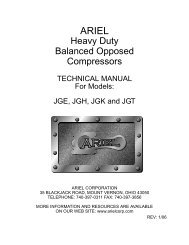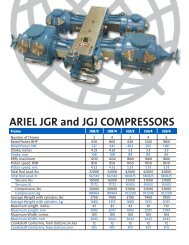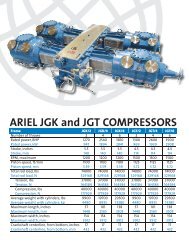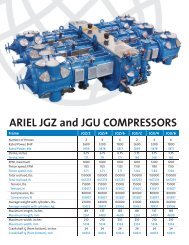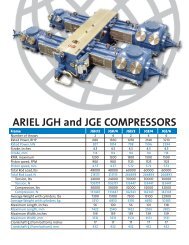Heavy Duty Balanced Opposed Compressors
Heavy Duty Balanced Opposed Compressors
Heavy Duty Balanced Opposed Compressors
Create successful ePaper yourself
Turn your PDF publications into a flip-book with our unique Google optimized e-Paper software.
FOR MODELS: JG AND JGA SECTION 5 - MAINTENANCE<br />
Wear Bands<br />
1-3/4JG-FS-HE Class pistons use one, one-piece angle cut filled Teflon wear band.<br />
Determining Wear Band Wear:<br />
Since the wear band does not work as a sealing ring, maximum end gap is not critical. The<br />
amount of wear band projection beyond the outer diameter of the piston is important. Wear<br />
band projection can be checked by measuring piston to cylinder bore clearance at the bottom<br />
of the bore. This can be done without removing the piston from the cylinder. Replace the<br />
wear band before it has worn enough to allow the piston to touch the cylinder bore.<br />
Piston Rings - Installation<br />
1. Place the rings over the grooves in the piston. Compress the Teflon one-piece<br />
rings by hand.<br />
2. With the rings fully compressed in the grooves, insert the rod and piston into the<br />
cylinder. Make sure the rings stay in place while inserting the piston and rod.<br />
NOTE: RING GAPS ARE TO BE STAGGERED AROUND THE PISTON, RATHER THAN<br />
IN LINE.<br />
3. Follow the steps under “Piston and Rod - Installation” on page 5-20.<br />
Wear Band - Installation<br />
Install the wear band as if it was another piston ring as above.<br />
Piston Rod Pressure Packing - Removal<br />
1. Remove the piston and piston rod. See “Piston and Rod - Removal” on page 5-<br />
18.<br />
2. Remove packing diaphragm and oil wiper packing.<br />
3. Disconnect the lube oil tube and/or coolant connections from the top of the packing<br />
gland and the primary vent tube from the bottom of the gland. Remove the<br />
twelve point capscrews that hold the pressure packing gland to the cylinder.<br />
4. At this point do not remove the small nuts from the studs. These studs hold the<br />
entire packing case together so it can be removed as an assembly.<br />
5. Screw two short 3/8-16 UNC capscrews into the two tapped holes provided in<br />
the crank end face of the packing gland. A screwdriver or pry bar under the<br />
heads of the capscrews can be used to pull the entire pressure packing out into<br />
the crosshead guide. It will then come out through the side opening of the guide.<br />
The pressure packing may now be taken to a clean place for disassembly.<br />
6. Set the pressure packing on a clean surface on its nose cup or cylinder end.<br />
Three long tie studs hold the pressure packing together. The stud holes are not<br />
PAGE 5 - 24 11/01





